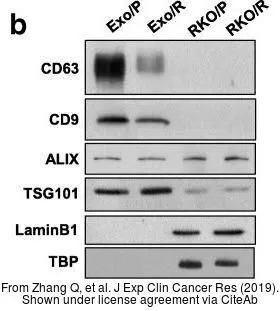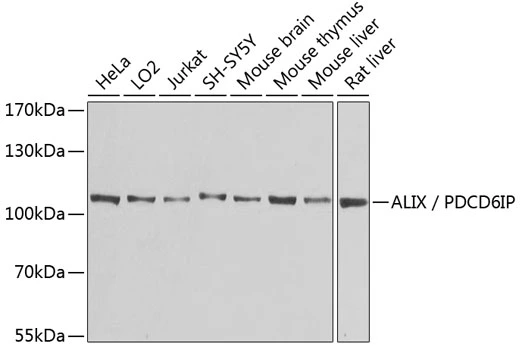
The data was published in the journal J Exp Clin Cancer Res in 2019. PMID: 31324203
ALIX antibody [3A9]
GTX42812
ApplicationsImmunoFluorescence, ImmunoPrecipitation, Western Blot, ELISA, ImmunoCytoChemistry, ImmunoHistoChemistry, ImmunoHistoChemistry Paraffin
Product group Antibodies
TargetPDCD6IP
Overview
- SupplierGeneTex
- Product NameALIX antibody [3A9]
- Delivery Days Customer9
- ApplicationsImmunoFluorescence, ImmunoPrecipitation, Western Blot, ELISA, ImmunoCytoChemistry, ImmunoHistoChemistry, ImmunoHistoChemistry Paraffin
- CertificationResearch Use Only
- ClonalityMonoclonal
- Clone ID3A9
- Concentration1 mg/ml
- ConjugateUnconjugated
- Gene ID10015
- Target namePDCD6IP
- Target descriptionprogrammed cell death 6 interacting protein
- Target synonymsAIP1, ALIX, DRIP4, HP95, MCPH29, programmed cell death 6-interacting protein, ALG-2 interacting protein 1, ALG-2-interacting protein X, PDCD6-interacting protein, apoptosis-linked gene 2-interacting protein X, dopamine receptor interacting protein 4
- HostMouse
- IsotypeIgG1
- Protein IDQ8WUM4
- Protein NameProgrammed cell death 6-interacting protein
- Scientific DescriptionThis gene encodes a protein that functions within the ESCRT pathway in the abscission stage of cytokinesis, in intralumenal endosomal vesicle formation, and in enveloped virus budding. Studies using mouse cells have shown that overexpression of this protein can block apoptosis. In addition, the product of this gene binds to the product of the PDCD6 gene, a protein required for apoptosis, in a calcium-dependent manner. This gene product also binds to endophilins, proteins that regulate membrane shape during endocytosis. Overexpression of this gene product and endophilins results in cytoplasmic vacuolization, which may be partly responsible for the protection against cell death. Several alternatively spliced transcript variants encoding different isoforms have been found for this gene. Related pseudogenes have been identified on chromosome 15. [provided by RefSeq, Jan 2012]
- Storage Instruction-20°C or -80°C,2°C to 8°C
- UNSPSC12352203
References
- Zhang Q, Liu RX, Chan KW, et al. Exosomal transfer of p-STAT3 promotes acquired 5-FU resistance in colorectal cancer cells. J Exp Clin Cancer Res. 2019,38(1):320. doi: 10.1186/s13046-019-1314-9Read this paper
- May EW, Lin ST, Lin CC, et al. Identification of up- and down-regulated proteins in doxorubicin-resistant uterine cancer cells: reticulocalbin-1 plays a key role in the development of doxorubicin-associated resistance. Pharmacol Res. 2014,90:1-17. doi: 10.1016/j.phrs.2014.08.007Read this paper

![WB analysis of HeLa cell lysate using GTX42812 ALIX antibody [3A9]. WB analysis of HeLa cell lysate using GTX42812 ALIX antibody [3A9].](https://www.genetex.com/upload/website/prouct_img/normal/GTX42812/GTX42812_71_WB_w_23060820_869.webp)


